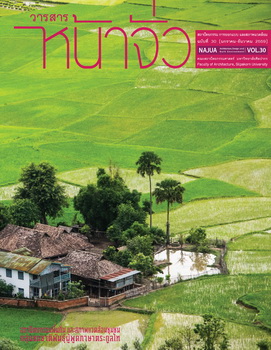สิ่งแวดล้อมสรรค์สร้างพื้นถิ่น: การดำรงและการเปลี่ยนแปลง
คำสำคัญ:
สิ่งแวดล้อมสรรค์สร้าง, ภูมิสถาปัตยกรรมพื้นถิ่น, สถาปัตยกรรมพื้นถิ่น, การดำรงและการเปลี่ยนแปลง, ไท, Built environment, Vernacular landscape, Vernacular architecture, Existing and change, Taiบทคัดย่อ
บทความเกี่ยวกับการดำรงและการเปลี่ยนแปลงของสิ่งแวดล้อมสรรค์สร้างพื้นถิ่นนี้ เกิดจากการศึกษาผ่านวิทยานิพนธ์ 2 เรื่อง ประกอบด้วย เรื่อง “การศึกษาภูมิทัศน์สรรค์สร้างท้องถิ่นไทยบริเวณที่อยู่อาศัยในพื้นที่ราบริมแม่นํ้าเพชรบุรี จังหวัดเพชรบุรี” และเรื่อง “การศึกษาเปรียบเทียบสถาปัตยกรรมพื้นถิ่นชุมชนไทลาว และชุมชนไทโคราช ณ อำเภอบัวใหญ่ จังหวัดนครราชสีมา” โดยมีสมมติฐานว่า สิ่งแวดล้อมสรรค์สร้างพื้นถิ่นมีการเปลี่ยนแปลงไปโดยลำดับ แต่ไม่ใช่การเปลี่ยนแปลงโดยสิ้นเชิง มีทั้งสิ่งที่สืบสานมาจากอดีตและสิ่งที่เปลี่ยนแปลงไปตามอิทธิพลจากภายนอกเกิดขึ้นในเวลาเดียวกัน
ผลการศึกษาเป็นการยืนยันสมมติฐานข้างต้น สำหรับภูมิทัศน์สรรค์สร้างท้องถิ่นไทยปรากฏชัดว่า แผนผังยังคงลักษณะเดิมๆ ขณะที่รั้วอันเป็นส่วนที่โอบล้อมโดยรอบมีการเปลี่ยนแปลงไปใช้วัสดุและรูปแบบใหม่ๆ ส่วนสถาปัตยกรรมพื้นถิ่นของกลุ่มคนไทนั้นการเปลี่ยนแปลงคล้อยไปในทำนองเดียวกัน กล่าวคือ ผังพื้นเรือนเป็นสิ่งที่ดำรงท่ามกลางการเปลี่ยนแปลงไปของรูปด้านและทรงหลังคา หมายความว่า โครงสร้างของพื้นที่ที่ซึ่งกิจกรรมของผู้คนดำเนินไปยังคงมีการสืบทอดมาจากอดีต สิ่งที่เปลี่ยนแปลงไปคือ ส่วนที่โอบล้อมอยู่ภายนอกซึ่งเผยต่อสาธารณะ
Vernacular Built-Environment: Persistence and Change
Vira Inpuntung
Faculty of Architecture, Silpakorn University
This article discusses persistence and changes in the vernacular builtenvironment. Stemming from two theses entitled “A study of local Thai vernacular built-landscape of dwelling communities on the flat plains of Phetchaburi River, Phetchaburi province” and “A comparative study of vernacular architecture of Tai Lao and Tai Korat communities in Bua Yai district, Nakhon Ratchasima province”, the discussion is based on the premise that vernacular built-environments transform in stages and do not change completely. Some elements from the past are retained while others change due to external influences.
Results of the studies confirm the above premise. It is apparent that the layout of Thai vernacular built-landscape has remained basically the same whilst outer fences surrounding the community have changed in appearance and resorted to using new materials. Similarly, vernacular house plan of the Tai people has remained the same whilst the elevations and roof forms have changed. This implies that spatial structure of the functions in which daily activities take place has been retained, whilst the outside envelope that is visible to the public, has changed in appearance.





